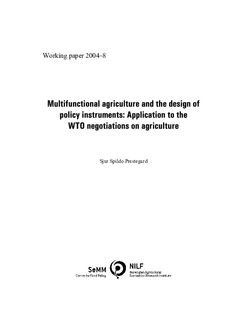Multifunctional agriculture and the design of policy instruments: Application to the WTO negotiations on agriculture
Research report
Published version
Permanent lenke
http://hdl.handle.net/11250/2499645Utgivelsesdato
2004-03Metadata
Vis full innførselSamlinger
- NILF Notat [338]
- Publikasjoner fra CRIStin - NIBIO [4493]
Sammendrag
Norway, Switzerland, the European Union, Korea, Japan and some other countries place substantial emphasis on the so-called non-trade concerns in the ongoing WTO negotiations on further agricultural trade liberalisation. In addition to the production of food and fibre, agriculture also may provide national food security, environmental benefits, and viable rural areas. The term «multifunctional agriculture» has been increasingly applied to describe these additional functions. This working paper focuses on how to achieve the multifunctional goals that nations may have with minimal tradedistortion. In this study, the economic concepts of externalities and public goods are used to analyse non-trade concerns and multifunctional agriculture. It is argued that just as a tax is widely accepted as the optimum policy for a negative externality, so should the use of a production-tied subsidy or payment be accepted as optimum policy for a positive externality or public good that is produced jointly with or complementary to agricultural production. The study concludes with suggestions for international trade rules to prevent such policies from becoming a form of protectionism. Multifunctional agriculture and the design of policy instruments: Application to the WTO negotiations on agriculture
